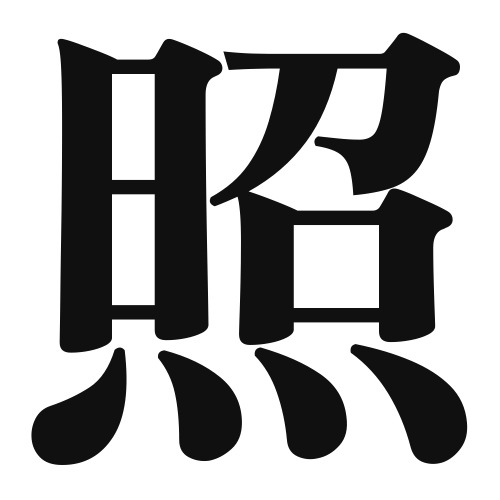1. Overview of Meaning
The kanji “照” (shou) primarily means “shine,” “illuminate,” or “reflect.” It conveys the idea of light and brightness, often associated with clarity and visibility.
2. Formation and Radical
Formation of the Kanji: The kanji “照” is a phono-semantic compound (形声文字), which means it combines both a phonetic and a semantic component. The left part, “火” (fire), suggests something related to light or heat, while the right part, “照” (shou), indicates the sound.
Radical: The radical of “照” is “火” (fire), which is commonly associated with light and warmth.
3. Examples of Usage
Common Words and Phrases: Some frequently used words that include “照” are:
- 照明 (しょうめい, shoumei) – lighting
- 照らす (てらす, terasu) – to illuminate
- 照合 (しょうごう, shougou) – verification
Example Sentences in Daily Conversation:
- この部屋は照明が明るいです。 (このへやはしょうめいがあかるいです。) – This room has bright lighting.
- 月が空を照らしています。 (つきがそらをてらしています。) – The moon is illuminating the sky.
4. Synonyms and Antonyms
Similar Kanji: A similar kanji is “光” (hikari), which means “light.” While both kanji relate to brightness, “光” emphasizes the concept of light itself, whereas “照” focuses on the act of shining or illuminating.
Opposite Kanji: An antonym of “照” is “暗” (an), which means “dark” or “darkness.” This kanji represents the absence of light.
5. Cultural and Historical Background
Relation to Japanese Culture: The concept of light and illumination is significant in Japanese culture, often symbolizing hope and clarity. Festivals like “Hanabi” (fireworks) celebrate light in various forms.
Proverbs and Idioms: One common saying is “照らし合わせる” (てらしあわせる, terashiawaseru), which means “to compare” or “to cross-check,” reflecting the idea of bringing things to light for better understanding.
